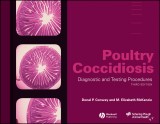Details

Poultry Coccidiosis
Diagnostic and Testing Procedures3. Aufl.
|
63,00 € |
|
| Verlag: | Wiley-Blackwell |
| Format: | |
| Veröffentl.: | 15.06.2007 |
| ISBN/EAN: | 9780470344323 |
| Sprache: | englisch |
| Anzahl Seiten: | 168 |
DRM-geschütztes eBook, Sie benötigen z.B. Adobe Digital Editions und eine Adobe ID zum Lesen.
Beschreibungen
<i>Poultry Coccidiosis</i> is a valuable, comprehensive reference that reviews the biology of coccidia, covers current diagnostic and testing procedures, and thoroughly covers the anti-coccidial vaccines and drugs that are currently available. This user-friendly guide will provide poultry scientists, poultry disease diagnosticians, and veterinary practitioners with a well-illustrated description of the Johnson and Reid scoring procedure, thorough explanation of laboratory procedures, experiment design, example protocols for testing anticoccidial drugs, a summary of the chemical name, structure, safety, and efficacy of anticoccidial drugs, and a review of anticoccidial vaccines that are currently available. This easy-to-use reference will be an invaluable tool for anyone working with poultry.
Preface. <p><b>Chapter 1. Introduction to Coccidiosis</b>.</p> <p>Diagnostic Chart.</p> <p>Coccidial Life Cycle.</p> <p>Diagnostic Procedure.</p> <p>References.</p> <p><b>Chapter 2. Examination of Lesions and Lesion Scoring.</b></p> <p>Lesion Scoring (Johnson and Reid Method).</p> <p>Lesions of Major Species.</p> <p>References.</p> <p><b>Chapter 3. Preparation of Oocysts</b>.</p> <p>Oocyst Collection.</p> <p>Sporulation and Storage.</p> <p>Oocyst Counting.</p> <p>Propagation.</p> <p>Calibration of a Microscope for Measuring Oocysts.</p> <p>References.</p> <p><b>Chapter 4. Basic Procedures and Example Protocols for Testing Anticoccidial Drugs.</b></p> <p>Battery Tests.</p> <p>Floor Pen Tests.</p> <p>Commercial Tests.</p> <p>References.</p> <p><b>Chapter 5. Coccidiosis Epidemiology and Control</b>.</p> <p>Factors Influencing the Occurrence of Coccidiosis.</p> <p>Basic Elements of Coccidiosis Control.</p> <p>Application of Anticoccidial Drugs and Vaccines.</p> <p>Management of the Host Environment.</p> <p>Feed Quality Control.</p> <p>References.</p> <p><b>Chapter 6. Anticoccidial Drugs and Vaccines</b>.</p> <p>Anticoccidial Drugs.</p> <p>Amprolium.</p> <p>Amprolium + Ethopabate.</p> <p>Amprolium + Ethopabate + Sulfaquinoxaline.</p> <p>Arprinocid.</p> <p>Clopidol (Meticlorpindol, Clopindol) Clopidol + Nequinate (Methyl Benzoquate).</p> <p>Folate Antagonists and Inhibitors.</p> <p>1. Diaminopyrimidines.</p> <p>2. Sulfadimethoxine.</p> <p>3. Sulfaguanidine.</p> <p>4. Sulfamethazine (Sulphamezathine, Sulfadimerazine, Sulfadimidine).</p> <p>5. Sulfanilamide.</p> <p>6. Sulfaquinoxaline.</p> <p>Glycarbylamide.</p> <p>Halofuginone Hydrobromide.</p> <p>4-Hydroxyquinolines.</p> <p>1. Buquinolate.</p> <p>2. Decoquinate.</p> <p>3. Nequinate (Methyl Benzoquate).</p> <p>Nicarbazin.</p> <p>Nitrobenzamides.</p> <p>1. Dinitolmide (Zoalene).</p> <p>2. Aklomide + Sulfanitran.</p> <p>3. Nitromide + Sulfanitran + Roxarsone.</p> <p>Nitrophenide.</p> <p>Nitrofurans.</p> <p>1. Furazolidone.</p> <p>2. Nihydrazone.</p> <p>3. Nitrofurazone.</p> <p>Organic Arsenicals.</p> <p>1. Oxophenylarsine (Arsenosobenzene).</p> <p>2. Roxarsone.</p> <p>Polyether Ionophores.</p> <p>1. Lasalocid.</p> <p>2. Maduramicin Ammonium.</p> <p>3. Monensin Sodium.</p> <p>4. Narasin.</p> <p>5. Narasin + Nicarbazin.</p> <p>6. Salinomycin Sodium.</p> <p>7. Semduramicin.</p> <p>Robenidine Hydrochloride.</p> <p>Steroidal Sapogenin.</p> <p>Triazines.</p> <p>1. Diclazuril.</p> <p>2. Toltrazuril.</p> <p>Anticoccidial Vaccines.</p> <p>Coccivac.</p> <p>Immucox.</p> <p>Nobilis COX ATM.</p> <p>Advent.</p> <p>Inovocox.</p> <p>Livacox.</p> <p>Paracox.</p> <p>CoxAbic.</p> <p>References</p>
<b>Donal P. Conway</b>, PhD, owns Conway Associates, a firm specializing in animal health product development and technical services.<br /> <p><b>M. Elizabeth McKenzie</b>, PhD, is the Director of U.S. Regulatory Affairs, Veterinary Medicine Research and Development, Animal Health Group, Pfizer Inc.</p>
<i>Poultry Coccidiosis</i> is a valuable, comprehensive reference on coccidial infrections, diagnostics, and treatment in chickens. This volume reviews the biology of Eimeria, current diagnostic and testing procedures, and the anti-coccidial vaccines and drugs that are currently available. This user-friendly guide will provide poultry scientists, poultry disease diagnosticians, and veterinary practitioners with a well-illustrated description of the Johnson and Reid scoring procedure, thorough explanation of laboratory procedures, experiment design, example protocols for testing anticoccidial drugs, a summary of the chemical name, structure, safety, and efficacy of anticoccidial drugs, and information on anticoccidial vaccines. This easy-to-use reference will be an invaluable tool for anyone working with poultry.
Diese Produkte könnten Sie auch interessieren:

Nursery Rearing of Nonhuman Primates in the 21st Century

von: Gene P. Sackett, Gerald Ruppenthal, Kate Elias

213,99 €















